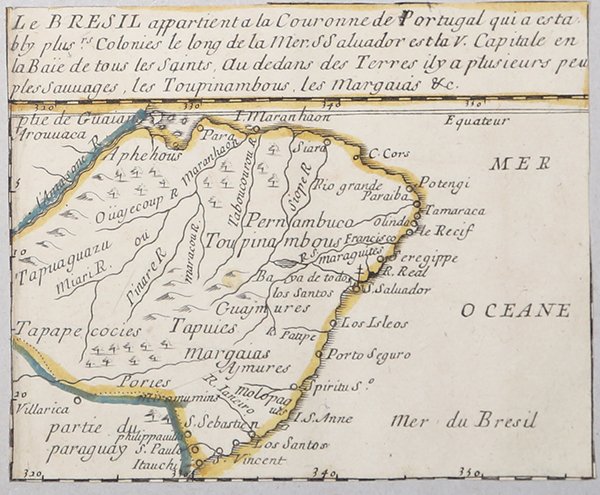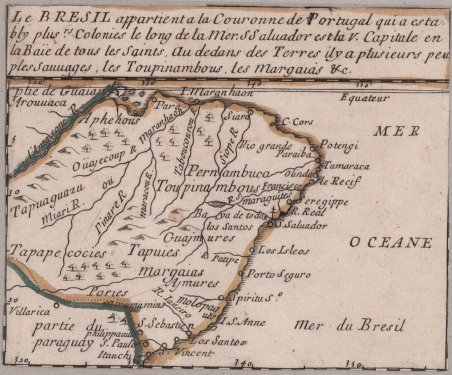Acquaforte, 1656 circa, con coloritura coeva dei contorni, in buone condizioni.Esemplare del secondo stato di due, con l’imprint di Jacques Lagniet e la data del 1661.La mappa proviene dal rarissimo foglio intitolato “L’Amerique par P. Du Val Geographe du Roy”, dal quale è stato ritagliato all’epoca - come anche certificato dalle antiche iscrizioni a inchiostro su alcune delle mappe - venendo applicato su un supporto di carta contemporanea, a formare un piccolo atlante in-sedicesimo oblungo.Secondo Philip Burden, lo scopo di questa rara curiosità cartografica di Pierre Duval non è noto. Fa parte di un insieme di quattro tavole raffiguranti i continenti. Può essere datato, per motivi cartografici, all’incirca nel 1656. L’unico esemplare del primo stato del foglio dell’America noto all’autore proviene dalla John Evelyn Library. Il secondo stato del foglio reca l’imprint aggiuntivo di Jacques Lagniet e la data del 1661 (cfr. Burden, The Mapping of North America, pagg. 417-418, n. 322). Burden elenca solo 2 esemplari del secondo stato, in una collezione americana privata (The Glen McLaughlin Map Collection of California as Island, oggi conservata presso la Stanford University) e presso la Bibliotheque National de France (che possiede l’insieme dei quattro continenti).La raccolta di mappe americane di Pierre Duval è sia rara che insolita. Il foglio contiene 18 singole mappe di varie parti del Nord e del Sud America. La mappa generale in alto a sinistra è disegnata dalla mappa di formato in-folio dello stesso Duval (1655), che mostra l’isola della California, senza Grandi Laghi, e una grande massa denominata “Terre de Iesso” che si estende tra l’Asia e il Nord America.Ce ne sono otto dedicati al Nord America; quattro dei quali sono basati sulle mappe di Sanson del 1656 - Le Canada, La Nle. Espagne, Le N. Mexique e La Floride. Il confronto di Burden con le mappe di Sanson lo porta a credere che la mappa di Duval potrebbe aver preceduto la carta di Guadalajara di Sanson o forse essere stata pubblicata contemporaneamente, rendendo questa mappa del New Mexico effettivamente la prima dedicata all’isola della California. Le quattro piccole mappe lungo il centro della fila inferiore: La Virginie, La Nle. Holande, La Nle. Suede e Le Nouveau Danemarq sono estremamente interessanti perché ci sono poche mappe contemporanee dedicate a queste regioni. La mappa di New Holland mostra la parte inferiore del R. del Nort (fiume Hudson). La mappa della Nuova Svezia è la prima mappa a concentrarsi sul fiume Delaware. La mappa della Nuova Danimarca raffigura la regione artica rivendicata dalla Danimarca a nord-ovest della baia di Hudson, qui etichettata Mer Christiane.Le altre mappe sul foglio includono due dedicate alle Indie occidentali e sette mappe regionali del Sud America: La Guiane, La Castille d'Or, Le Perou, Le Bresil, Le Chili, Le Paraguay e La Magellanique. Etching, circa 1656, with contemporary outline colour, good condition.Example of the second state of two, with the imprint of Jacques Lagniet and the date 1661.The map comes from the very rare sheet entitled “L’Amerique par P. Du Val Geographe du Roy”, from which it was cut at the time and laid down on contemporary laid paper support, to form a small atlas, as certified by the ancient ink inscriptions on some of the maps.According with Philip Burden “The purpose of this rare curiosity by Pierre Duval is not known. It forms part of a set of the four known continents. It can be dated to apporximately 1656 […] The only example of the first state known to the author come from the John Evelyn Library in the early 1980s. The second state bears the additional imprint of Jacques Lagniet and the date 1661”. (cf. Burden, The Mapping of North America, pp. 417-418, n. 322). Burden list only 2 example of the second state, in a private American collection (The Glen McLaughlin Map Collection of California as an Island, at Stanford University) and at the Bibliotheque National de France (that own all the set of four continents).Pierre Duval's compilation of American maps is both rare and unusual. The sheet contains 18 individual maps of various parts of North and South America. The general map at top left is drawn from Duval's own folio map of 1655, which features the island of California, no Great Lakes, and a large Terre de Iesso stretching between Asia and North America.There are eight devoted to North America; four of which are based on Sanson's maps of 1656 - Le Canada, La Nle. Espagne, Le N. Mexique, and La Floride. Burden's comparison with Sanson's maps leads him to believe that Duval's map may have preceded Sanson's Audience de Guadalajara or possibly were published concurrently, making this map of New Mexico actually the first devoted to the island of California. Interestingly, on the small map the island is presented on the Foxe model, while on the general map it is shown on the Briggs format. The four small maps along the center of the bottom row - La Virginie, La Nle. Holande, La Nle. Suede, and Le Nouveau Danemarq are extremely interesting because there are few contemporary maps devoted to these regions. The map of New Holland features the lower part of the R. del Nort (Hudson River). The map of New Sweden is the first map to focus on the Delaware River. The map of New Denmark depicts the Arctic region claimed by Denmark to the northwest of Hudson Bay, here labeled Mer Christiane.The other maps on the sheet include two devoted to the West Indies, and seven regional maps of South America - La Guiane, La Castille d'Or, Le Perou, Le Bresil, Le Chili, Le Paraguay, and La Magellanique. Cfr. Burden, The Mapping of America, n. 322, II/II; Pastoureau (1984) p. 136; cf. Betz, The Mapping of Africa, pp. 294, 295, n. 85; cf. J. Hubbard, Japoniae Insulae. The Mapping of Japan, pp. 199-201, n. 28.


Découvrez comment utiliser
Découvrez comment utiliser

